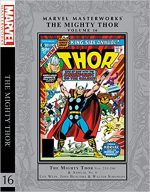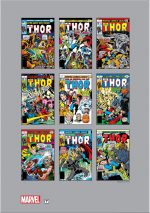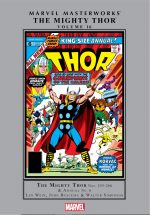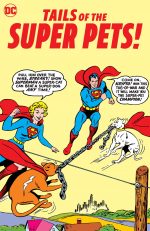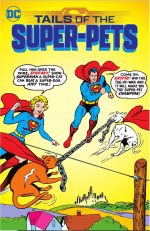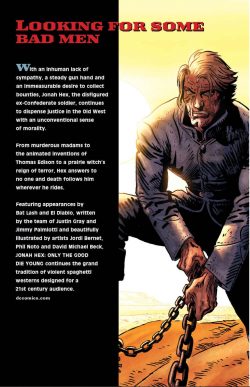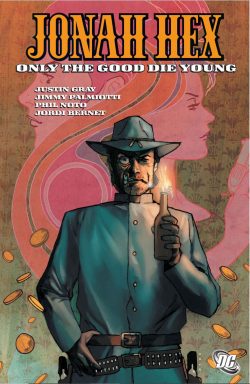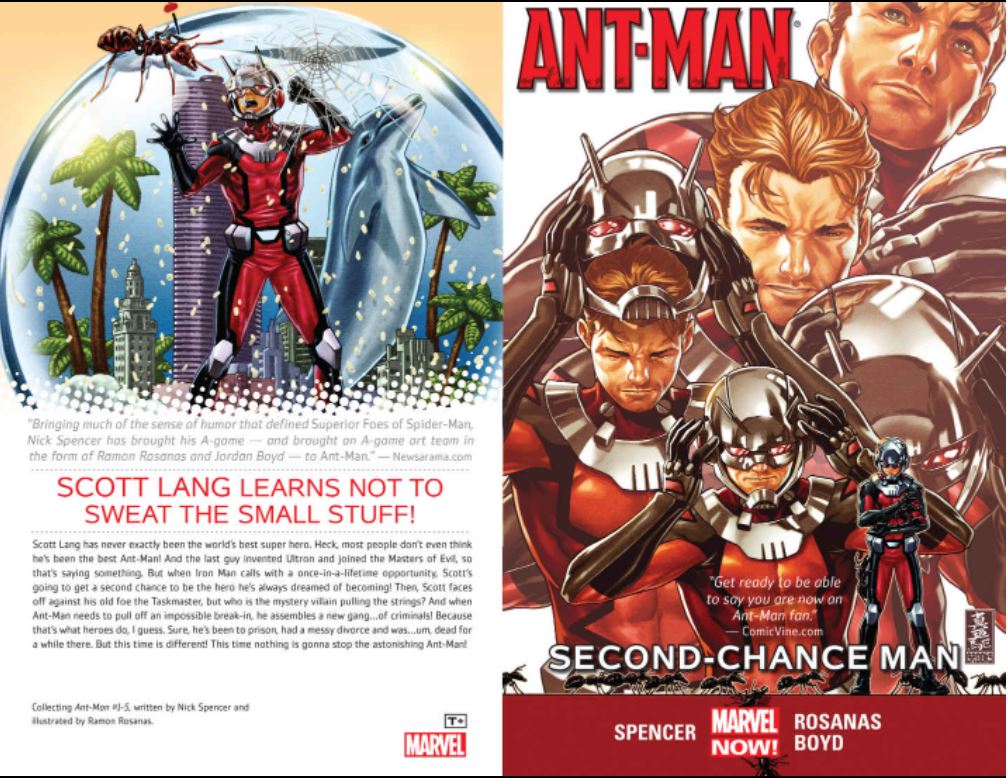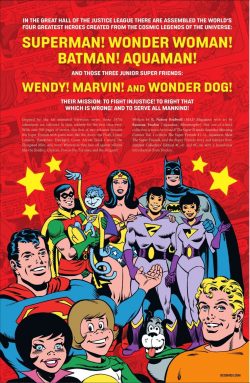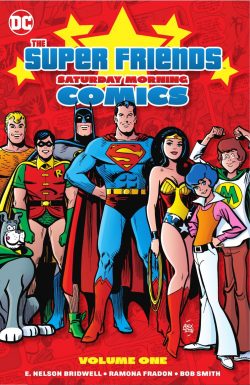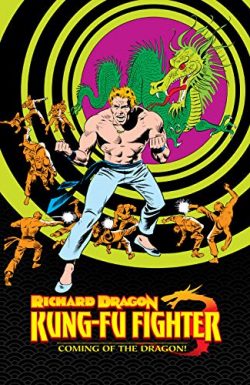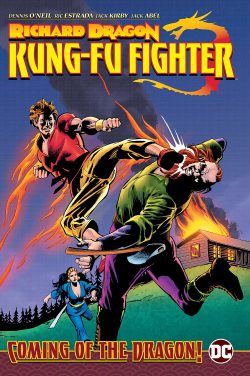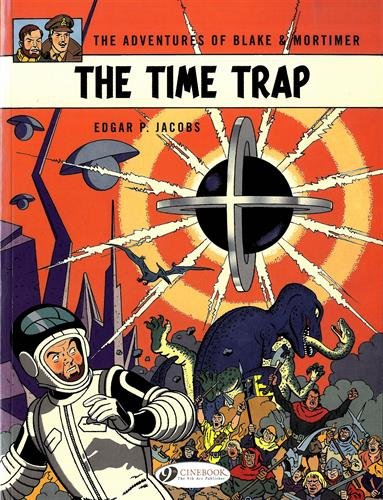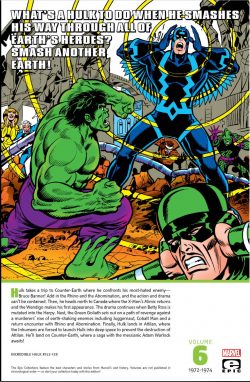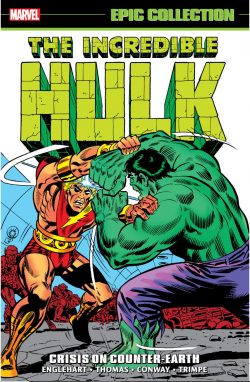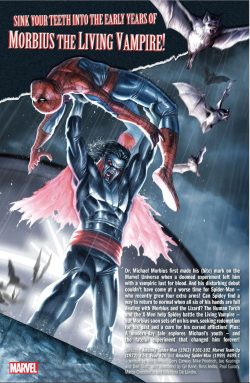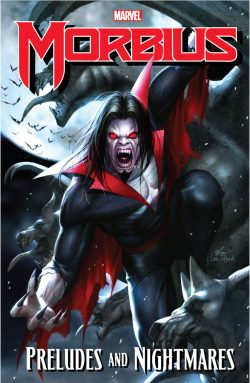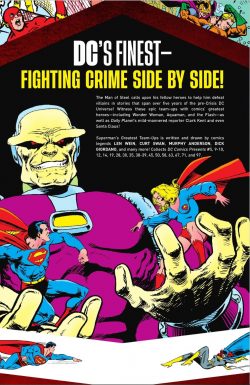
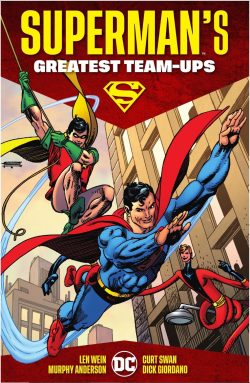
By Mike W. Barr, Cary Bates, E. Nelson Bridwell, Gary Cohn, Gerry Conway, Steve Englehart, Steve Gerber, Paul Levitz, Dan Mishkin, Denny O’Neil, Martin Pasko, Len Wein, Murphy Anderson, Rich Buckler, Dick Dillin, Don Heck, Alex Saviuk, Jim Starlin, Joe Staton, Curt Swan, Rick Veitch & various (DC Comics)
ISBN: 978-1-7795-0486-9 (HB/Digital edition)
From the moment a kid first sees his second superhero, the only thing they wants is to see how the new gaudy gladiator stacks up against the first one. From the earliest days of the comics industry (and according to DC Comics Presents editor Julie Schwartz it was the same with the pulps and dime novels that preceded it) we’ve wanted our idols to meet, associate, battle together – and if you follow the Timely/Marvel model, that means against each other – far more than we want to see them trounce their archenemies in a united front…
The concept of team-up books – an established star pairing or battling (usually both) with less well-selling company characters – was far from new when DC awarded their then-biggest gun. DCCP was launched in the publicity-drenched weeks preceding the release of Superman: The Movie: a regular arena to have adventures with other stars of their firmament, just as the Gotham Guardian had been doing since the mid-1960s in The Brave and the Bold.
In truth, the Action Ace had already enjoyed the serial sharing experience once before, when World’s Finest Comics briefly ejected the Caped Crusader and Superman battled beside a coterie of heroes including Flash, Robin, Wonder Woman, Teen Titans, Hawkman, Green Arrow, Dr. Fate and others (issues #198-214; November 1970 to October/November 1972) before the original status quo was re-established.
This is something of a companion volume to the previously published Adventures of Superman: José Luis GarcÃa-López volume 1, in that it also publishes team-ups from DC Comics Presents, but these are stories he didn’t illustrate. Instead. a host of talented individuals devised fun, thrilling and even amusing adventures represented here by material from DCCP #5, 9-10, 12, 14, 19, 28, 30, 35, 38-39, 45, 50, 58, 63, 67, 71 and 97, spanning January 1979 to September 1986. The stories are augmented by covers by Ross Andru, Dick Giordano, Dick Dillin, Jim Starlin, Rich Buckler, Steve Mitchell, George Pérez, Frank Giacoia, Gil Kane, Ernie Colón, José Luis GarcÃa-López, Eduardo Barreto, Rick Veitch & Bob Smith.
We begin with Sea King Aquaman who is embroiled in ‘The War of the Undersea Cities’ (by Len Wein, Paul Levitz & Murphy Anderson) when his subjects re-open ancient hostilities with the mer-folk of undersea neighbour Tritonis, home of Superman’s old college girlfriend Lori Lemaris. Fortunately, cooler heads prevail when Ocean Master is revealed to be meddling in their sub-sea politics…
Next, Marty Pasko, Joe Staton & Jack Abel expose the ‘Invasion of the Ice People!’ (#9, May 1979) wherein Wonder Woman assists in repelling an attack by malign disembodied intellects before a 2-part tale commences with ‘The Miracle Man of Easy Company’ (Cary Bates, Staton & Abel, #10, June)…
When a super-bomb blasts Superman back to World War II it results in a momentous meeting with indomitable everyman soldier Sgt. Rock and a battle that changes the course of the war.
Cover-dated August 1979, DCCP #12 offered a duel between the Action Ace and New God Mister Miracle in ‘Winner Take Metropolis’ – by Steve Englehart, Buckler & Giordano before Levitz finishes a time-travel epic not actually included here. That ambitious continued epic saw the Legion of Super-Heroes stop Superman saving a little boy from alien abduction to preserve the integrity of the time-line. It didn’t help that the lad was Jon Ross, son of Clark Kent’s oldest friend and most trusted confidante…
Deranged by loss, Pete Ross here risks the destruction of all reality by enlisting the aid of Superboy to battle his older self in ‘Judge, Jury… and No Justice!’ (Levitz, Dillin & Giordano from October 1979 cover-dated DCCP #14, whilst March 1980 saw Batgirl help solve eerie mystery ‘Who Haunts This House?’ (by Dennis O’Neil, Staton & Frank Chiaramonte) before we catapult to #28 and the concluding chapter of a cosmic epic which involved Green Lantern, Martian Manhunter J’onn J’onzz, and the debut of intergalactic brute Mongul.
Here the aftermath of the affair sees Supergirl join her Kryptonian cousin in scouring the cosmos for the vanished tyrant and ancient doom weapon ‘Warworld!’ (Wein, Jim Starlin & Romeo Tanghal). Unfortunately, once they found it, Mongul unleashed all its resources to destroy his annoying adversaries and in the resultant cataclysm the mobile gun-planet was demolished. The resultant detonation blasted Kara Zor-El literally out of existence…
Issue #30 (February 1981) saw Black Canary plagued by nightmares starring her deceased husband, but upon closer investigation Superman proved that diabolical Dr. Destiny was behind ‘A Dream of Demons!’, whilst some semblance of sanity returned in #35 (July) as Superman and Man-Bat hunted for ‘The Metamorphosis Machine!’ (Pasko, Swan & Vince Colletta) which might save chiropterist Kirk Langstrom‘s baby daughter from death. All they had to do was beat murderous maniac Atomic Skull and his minions to the device…
DC Comics Presents #38 (October) united Man of Steel and Fastest Man Alive as an extra-dimensional tyrant attempted to foment a high velocity war between Earth’s fastest heroes in ‘Stop the World – I Want to Get Off Go Home!’ (Pasko & Don Heck), after which #39 catapulted Superman into the weirdest case of his career as he and Plastic Man trailed ‘The Thing That Goes Woof in the Night!’ (Pasko, Staton & Smith) to a Toymakers Convention where third-rate super-villains Fliptop and Dollface were trying to rob freshly reformed, barely recovering maniac Toyman…
Firestorm the Nuclear Man stole the show in #45 (May 1982) as Gerry Conway, Buckler & Smith teamed him and Superman against terrorist Kriss-Kross – who took over the nation’s electronic military defences to implement ‘The Chaos Network’.
The anniversary DC Comics Presents #50 (October) features ‘When You Wish Upon a Planetoid!’ by Dan Mishkin, Gary Cohn, Swan & Kurt Schaffenberger, which saw a cosmic calamity split Superman and Clark Kent into separate entities…
Courtesy of Mike W. Barr, Swan & Dave Hunt, Robin and Elongated Man joined the Action Ace in #58 (June 1983) to foil devious tech-savvy bandits employing ‘The Deadly Touch of the Intangibles’ after which overnight sensation Amethyst, Princess of Gemworld and the Man of Steel battled debase extradimensional tyrant Black Opal in #63 (November 1983).
Scripted by Mishkin & Cohn, ‘Worlds to Conquer!’ was illustrated by Alex Saviuk, Colón, Smith & Gary Martin, capitalising on the contemporary fad for fantasy, with an Earth-raised magical alien princess helping save humanity from roaming space-warps, super-criminals and her personal pantheon of mystic miscreants…
Cover-dated March 1984, DCCP #67 proffered traditional seasonal fare from Wein, E. Nelson Bridwell and veteran Superman dream team Swan & Anderson. ‘Twas the Fright Before Christmas!’ finds maniacal original Toyman Winslow Schott seeking to sabotage festivities and a debilitated Man of Tomorrow teaming with a hairy bearded guy in a red suit…
Hunt substituted for Anderson in #71’s ‘The Mark of Bizarro!’ (July 1984) as Superman joins his zany doppelganger to save square planet Htrae and embattled Earth from a bizarro version of power-parasite Amazo. Ultimately, it comes down to Bizarro employing his wits to win!…
We close with the final story in DC Comics Presents‘ run.
In 1986 DC celebrated its 50th year with the groundbreaking Crisis on Infinite Earths: radically overhauling its convoluted multiversal continuity and starting afresh. In the aftermath of making many planes into one singular universe, all Superman titles were cancelled or suspended pending a back-to-basics reboot courtesy of John Byrne. The process allowed opportunity for a number of very special farewells to the old mythology…
One of the most intriguing and challenging came in the last issue (#97, September 1986) wherein Steve Gerber, Rick Veitch & Smith offered a creepy adieu to many of Superman’s greatest foes in ‘Phantom Zone: the Final Chapter’…
Tracing Jor-El‘s discovery of the Phantom Zone through to the imminent end of the multiverse, this dark yarn built on Gerber’s potent miniseries The Phantom Zone, revealing the dread region of nothingness was in fact the sentient echo of a dead universe which had always regarded the creatures deposited within it as irritants and agonising intruders.
Now, as cosmic carnage reigned, Aethyr, served by Kryptonian mage Thul-Kar, caused the destruction of Bizarro World Htrae and deification/corruption of Fifth Dimensional pest Mr. Mxyzptlk, as well as the subsequent crashing of Krypton’s Argo City on Metropolis.
As a result, General Zod and his fellow immaterial inmates were liberated to wreak havoc upon Earth – but only until the now-crystalline pocket dimension merged with and absorbed the felons before implausibly abandoning Superman to face his uncertain future as the very Last Son of Krypton…
Designed as introductions to lesser-known DC stars, these tales are wonderfully accessible to newcomers and readers unfamiliar with burdensome continuity. They provide an ideal jumping on point for anybody who just wants a few moments of easy comic book fun and thrills.
These short, pithy adventures were and remain a perfect shop window for DC’s fascinating catalogue of characters and creators. DC Comics Presents delivered a breadth and variety of self-contained and satisfying entertainments ranging from the merely excellent to utterly indispensable. This book is a perfect introduction to the DC Universe for every kid of any age and another delightful slice of captivating Costumed Dramas from simpler, more inviting times…
© 1979, 1980, 1981, 1982, 1983, 1984, 1986, 2021 DC Comics. All Rights Reserved.

